Why is Augmented Reality in Real Estate Important?
5 Examples of Augmented Reality in Real Estate
Today’s real estate sector faces many challenges: difficulties in coordinating the busy schedules of buyers and agents, for example; and the difficulty buyers may have in sorting through and visiting multiple listings to find the right property.
The costs associated with open house events, marketing materials, and home “staging” have become substantial burdens for real estate professionals. For instance, research shows the real estate sector allocated about $719 million solely for advertising in 2023. All of these issues can be addressed in part by integrating immersive Augmented Reality (AR) technology.
In this blog post, we will explore why AR has become such an important tool for real estate professionals.
Why is Augmented Reality in Real Estate Important?
5 Examples of Augmented Reality in Real Estate
Augmented Reality involves overlaying digital content onto the real physical world in real-time, commonly using devices such as smartphones and tablets. In the field of real estate, AR makes it possible to present prospective buyers with virtual 3D models of buildings, virtual tours, interactive floor plans, apartment designs, and more — all superimposed onto a view of the property as seen through the camera on a user’s device.
AR apps developed specifically for real estate use spatial mapping to accurately place virtual elements where they would exist in the real world. This allows prospective buyers, for example, to walk through and visually experience a home’s interior layout and features before even stepping foot inside.
The study reveals that approximately 81% of potential buyers like the option of exploring 3D and virtual tours when searching for houses. So, let’s discuss why trend-setting companies are now providing real estate services that use these efficient digital options.

Augmented Reality in real estate helps create a more engaging and interactive viewing experience, aiming to reach a total market value of $54.95 billion by 2033. Some key reasons why real estate companies are rapidly adopting this innovative approach is that it:
The realistic visualizations of AR offer something more intriguing than photographs or even video. AR gives potential buyers the ability to navigate buildings from 360 degrees, interact with virtual elements, and examine every inch of a listing as if they were physically present. This is particularly beneficial for those who are unable to physically visit the property at the moment.
AR also offers significant benefits in the context of new construction and renovations, as it bridges the gap between traditional 2D property representations and the visualization of projects that are yet to be realized. Leveraging the technical capabilities of AR lets stakeholders envision and explore future developments more accurately.
Want to create an AR solution for your real estate business? We’re ready to help!HQSoftware has a team of skilled professionals ready to tackle the project. Ask me!
Anna Halias
Business Development Manager
From start to finish, Augmented Reality in real estate streamlines the process of screening listings in the following ways:
All of this increases the likelihood of satisfying results.
Projected revenue of $5.2 billion by the end of 2024 underscores the growing importance of AR advertising as a strategic marketing approach. Here are some examples of using AR in real estate ad campaigns:
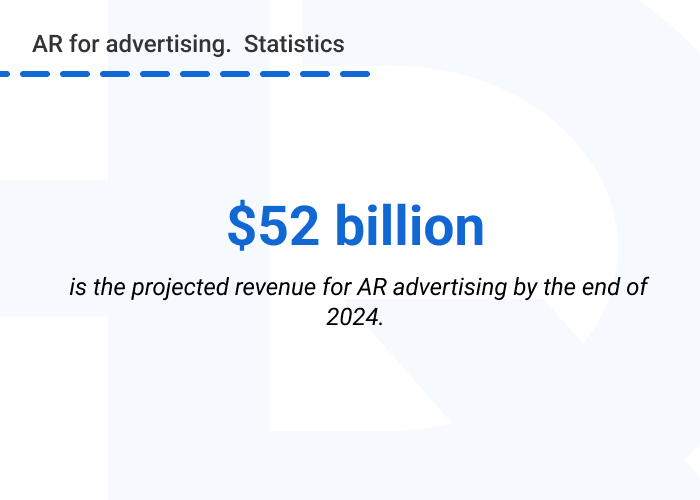
Studies reveal that implementing Augmented Reality leads to 90% higher conversion rates compared with not using AR. Here are some ways AR can save resources:
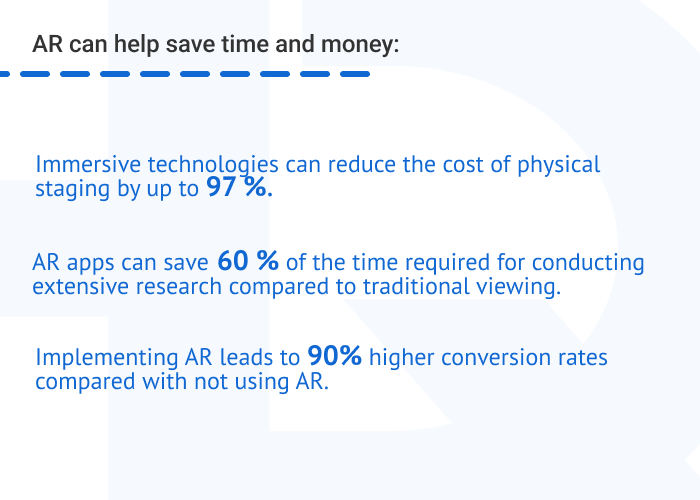
In so many ways, AR represents a leap forward in making property searches more informative. However, for a better picture, let’s explore some examples of AR applications in real estate.
The statistics say that 86% of potential new-build buyers are eager to use Augmented Reality to visualize planned views of their future homes before construction begins. The examples that we have collected demonstrate why AR has become an important tool for the real estate sector.
Listings in AR focus on immersive virtual previews to remotely screen and evaluate property options on any device. AR overlays can provide access to a wealth of information about the property, including 3D images, videos, and other property details. This information is readily available at the buyer’s fingertips, eliminating the need to search through multiple sources.
AR apps allow clients to immerse themselves in a digital recreation of their new home-to-be, testing out configurations, materials selections, and getting a highly realistic sense of how the finished product may appear once complete. This helps speed up a purchase decision.
Drive-by properties can automatically launch Augmented Reality listings with property details for on-the-spot consideration when potential buyers are walking by a new building.
By pointing a mobile device at a specific object or scanning a QR code or marker on a billboard, people can get various kinds of data about a property, such as room dimensions, property specifications, and real estate agent details.
One example is an AR mobile app to explore real estate options in the neighborhood that we engineered for our customers. By scanning and recognizing pre-defined buildings, the app provides information on available properties for sale or rent. This includes a short and full description of the selected property object, gallery, and price, as a text panel with an image.
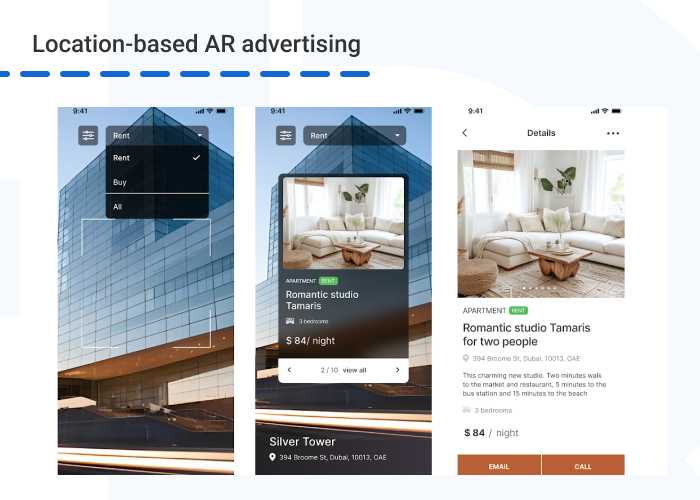
This kind of approach helps users evaluate potential housing choices and quickly make informed decisions.
Around 70% of potential buyers prefer property listings that offer virtual tours. AR-powered virtual tours allow you to “walk through” each room and even open drawers, cabinets, and appliances to conduct a thorough inspection of the interior from different points within the property.
AR virtual tours help increase engagement, both for individual properties and popular public attractions. For instance, museum visitors can embark on virtual tours that guide them through exhibits while offering supplementary information about each display.
By projecting scaled representations directly onto the real environment, Augmented Reality floor plans transform from static images to lively previews, promoting understanding of a property’s spatial dimensions. Here are some ways AR can be useful:
At HQSoftware, we have developed an AR mobile app for visualizing potential construction plans for building sites. Through interactive 3D modeling, sellers and buyers can view realistic previews of how land developments may take shape in the future.
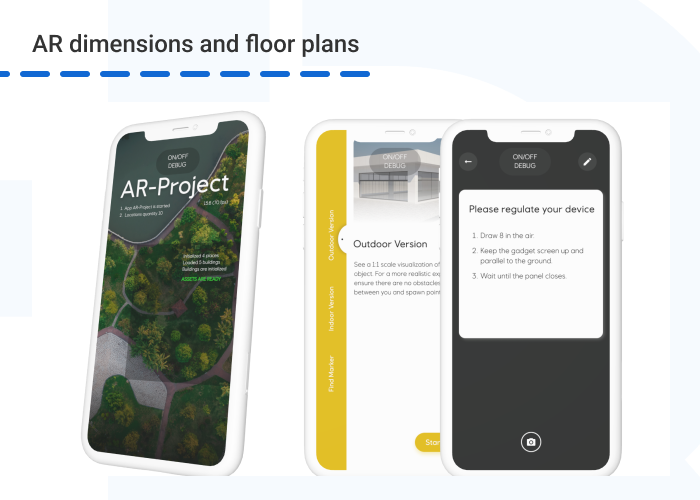
This provides a more comprehensive idea of upcoming construction projects and long-term site plans. This proved a real benefit to our client, which saw investments increase by up to 42%.
The power of AR design makes it possible to unlock the full potential of a property, allowing buyers to visualize its future state beyond its current limitations. This allows us to:
The IKEA Place AR app empowers users to immerse themselves within a home, office, school, or studio and try out various design ideas. With a wide range of 3D true-to-scale products available, from sofas and armchairs to coffee tables, IKEA Place ensures that every selection perfectly aligns with the desired functionality.
Having explored some of the compelling possibilities of AR real estate experiences, let’s now shift our attention to a step-by-step approach for integrating AR technology into your business.
By following these steps, you can successfully implement Augmented Reality technology into your real estate business.
Step 1. Hardware
When selecting hardware, choose devices that meet the minimum requirements and support AR capabilities. Smartphones and tablets running the latest versions of iOS and Android are suitable options, as they allow use of the ARCore and ARKit platforms. For more advanced AR experiences, you may also consider AR-enabled smart glasses.
At HQSoftware, we can offer you comprehensive consulting services to ensure seamless platform and device compatibility, refine app ideas, and assist in selecting the most suitable development approaches for your project.
Step 2. Designing and prototyping 3D models
Start by clearly defining the purpose of the 3D model. It could include houses, apartments, commercial buildings, etc. Then you need to gather architectural plans, measurements, photographs, and any additional details required for accurate modeling.
Design the interface to be easy to navigate, so users can quickly access the interactive features, such as 3D models or virtual tours. Consider including customizable options, such as voice control or text-to-speech methods, to ensure everyone can enjoy the AR experience.
Depending on your requirements, it could take about two to three weeks for our development team to create a fast AR prototype that allows us to visualize designs and experiment with concepts.
Step 3. Creating AR framework
This step focuses on the technical aspects of building your AR framework. There are many AR tools for model development available, including Unity, Unreal Engine, Blender, Maya, or 3ds Max. Among the useful AR platforms are Vuforia, ARCore, and ARKit. The choice of software depends on the project’s specific needs and the developer’s skillset.
Step 4. Testing
Put the program through quality assurance to fix any bugs. Test that all interactive elements function across different devices and operating systems. Verify dimensions, textures, and any specific architectural details to ensure a realistic representation of the buildings.
Our QA team leads utilize a blended approach, applying both manual and automated testing strategies. By determining the most effective mix of techniques, our QA team can allocate resources prudently to ensure comprehensive assurance.
How do modern businesses use AR to increase their revenues and outperform their industry competitors?

In summary, interactive Augmented Reality solutions make the property-search process more enjoyable while boosting customer confidence. AR gives a true sense of “being inside” even when viewing a space remotely. This level of virtual presence helps real estate companies streamline communications and more efficiently match properties to buyers’ needs.
By developing custom AR applications, HQSoftware can help real estate companies future-proof their technology toolbox. Whether you need an initial prototype or a full-featured AR app integrated with your listings database, our services cover the entire development lifecycle, from planning and modeling to deployment.
To learn more about how we can enhance your real estate business with custom AR solutions, please visit our AR/VR development services page.
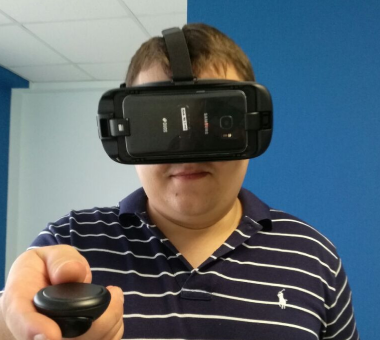
AR/VR Expert
A developer with extensive expertise in AR/VR, very ingrained into the topic of Mixed Reality development. Shares his knowledge and the results of many years of work.
We are open to seeing your business needs and determining the best solution. Complete this form, and receive a free personalized proposal from your dedicated manager.

Sergei Vardomatski
Founder